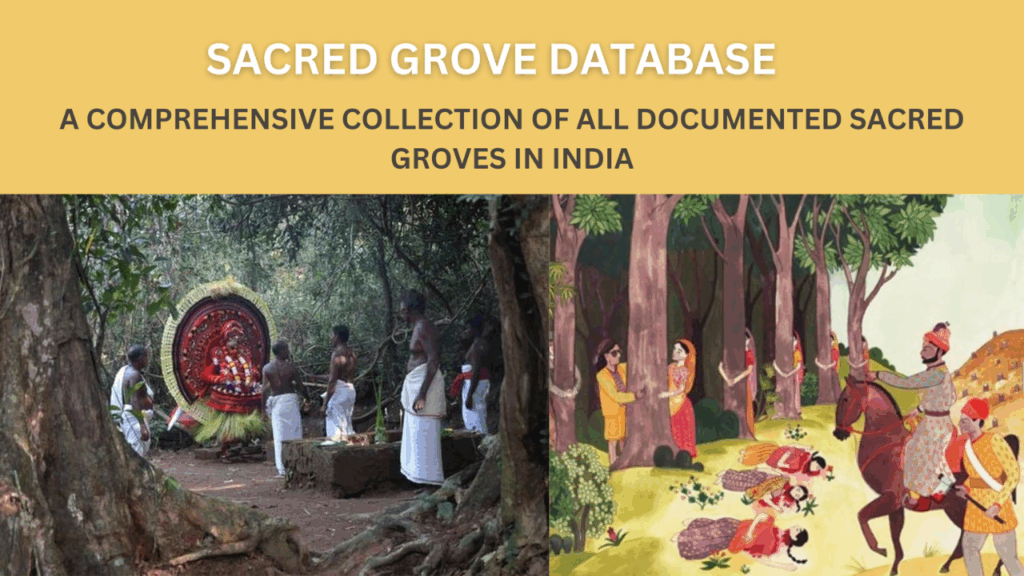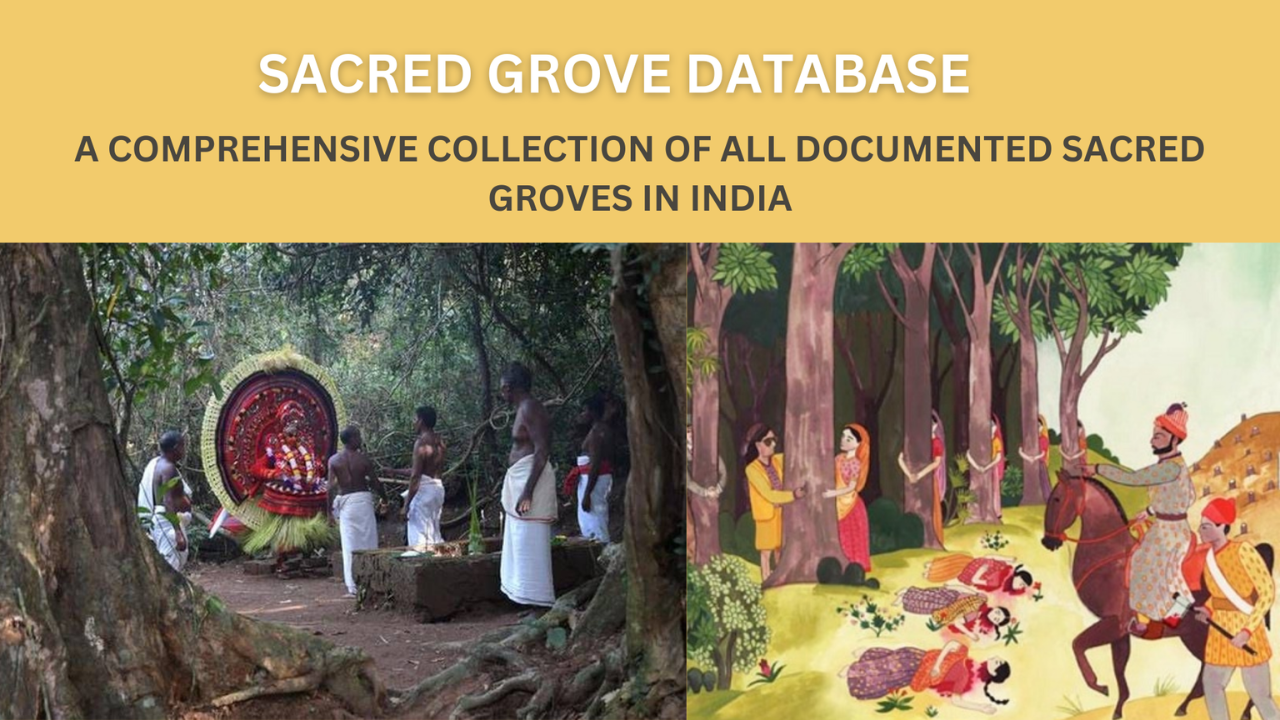
India’s biodiversity conservation has always drawn strength from both cultural traditions and legal frameworks. Two important approaches that reflect this synergy are the sacred groves—forests preserved by communities as part of religious and cultural practices—and Community Biodiversity Registers (CBRs), which document local biological resources and associated traditional knowledge. Together, they represent a bridge between customary conservation practices and modern legal frameworks for biodiversity management.
Sacred Groves: Ancient Traditions of Conservation
Sacred groves are patches of forest or natural landscapes dedicated to deities, ancestral spirits, or cultural beliefs. They are protected by communities and represent one of the oldest forms of biodiversity conservation in India.
Importance of Sacred Groves
- Biodiversity Reservoirs: Home to rare and endemic plant species.
- Water Security: Act as natural catchments, preserving water sources.
- Climate Regulation: Function as carbon sinks and micro-climate stabilizers.
- Cultural Heritage: Strengthen local traditions and spiritual identity.
- Conservation without Enforcement: Protection is community-driven, not law-enforced.
Examples
- Mawphlang Sacred Groves, Meghalaya – Rich in medicinal plants.
- Devarakadus of Karnataka – Protected by Kodava community traditions.
- Kavus of Kerala – Associated with serpent worship and wetland conservation.
Threats to Sacred Groves
Despite their cultural significance, sacred groves face multiple pressures:
- Urbanization and Development Projects encroaching upon traditional forest lands.
- Decline in Traditional Beliefs leading to reduced community vigilance.
- Resource Exploitation such as illegal logging and mining.
- Climate Change altering ecosystems and threatening species survival.
Community Biodiversity Registers (CBRs)
The Biological Diversity Act, 2002 introduced CBRs as a formal tool to document biodiversity. These registers are prepared and maintained by local bodies such as Biodiversity Management Committees (BMCs) under the guidance of the National Biodiversity Authority (NBA) and State Biodiversity Boards.
Objectives of CBRs
- Documentation of Biodiversity: Record local flora, fauna, and microbial diversity.
- Preserve Traditional Knowledge: Capture information about medicinal plants, crops, and cultural practices.
- Benefit Sharing: Facilitate equitable sharing of profits from the use of biological resources.
- Community Empowerment: Strengthen participation of local people in conservation.
- Legal Recognition: Provide evidence of traditional ownership and rights.
Legal and Policy Framework
- Biological Diversity Act, 2002 – Mandates the creation of CBRs and empowers BMCs.
- National Biodiversity Authority (NBA) – Regulates access to biodiversity and ensures benefit-sharing.
- Forest Rights Act, 2006 – Recognizes rights of forest communities, complementing CBR efforts.
- Panchayati Raj Institutions – Play a central role in maintaining local registers.
Comparative Table: Sacred Groves vs. CBRs
| Aspect | Sacred Groves | Community Biodiversity Registers |
|---|---|---|
| Origin | Traditional, cultural, and religious | Legal framework under Biological Diversity Act, 2002 |
| Protection Mechanism | Community faith and customary rules | Institutional documentation by BMCs |
| Focus | Specific patches of land/forest | Comprehensive biodiversity documentation |
| Strength | Deep-rooted cultural respect | Legal recognition and policy support |
| Limitation | Decline in cultural practices | Implementation gaps and lack of awareness |
Challenges in Implementation
Sacred Groves
- Weakening cultural values due to modernization.
- Lack of legal protection in many regions.
- Encroachment and resource exploitation.
CBRs
- Inadequate technical expertise at local level.
- Delays in documentation and weak monitoring.
- Low awareness about benefit-sharing provisions.
Overview Table
| Aspect | Sacred Groves | Community Biodiversity Registers |
|---|---|---|
| Purpose | Spiritual and cultural conservation | Legal documentation and benefit-sharing |
| Governing Authority | Local communities and traditions | Biodiversity Management Committees (BMCs) |
| Role in Biodiversity | Protects unique micro-ecosystems | Ensures large-scale biodiversity records |
| Major Benefit | In-situ conservation and water security | Legal protection and equitable sharing |
| Key Challenge | Cultural erosion and encroachment | Implementation and awareness gaps |
| Complementarity | Preserves actual habitats | Preserves knowledge and access rights |
Way Forward
- Integration of Traditional and Legal Frameworks: Sacred groves must be given legal backing under biodiversity laws.
- Community Awareness Programs: Strengthen cultural pride in sacred grove conservation.
- Digitization of CBRs: Use technology for easier documentation and wider accessibility.
- Incentives for Communities: Financial and policy incentives for those maintaining groves or preparing CBRs.
- Collaborative Governance: Linking local communities, NGOs, and government agencies for holistic conservation.
Conclusion
Sacred groves and Community Biodiversity Registers represent two pillars of biodiversity conservation in India—one rooted in tradition and culture, the other in law and policy. While sacred groves embody centuries-old practices of ecological stewardship, CBRs institutionalize biodiversity documentation and benefit-sharing under modern governance frameworks. Together, they highlight the importance of blending community values with state-led conservation to protect India’s rich natural heritage.
FAQs
Q1. What are sacred groves, and why are they important?
Sacred groves are community-protected forest patches linked to cultural and religious traditions, vital for biodiversity and water conservation.
Q2. What is the purpose of Community Biodiversity Registers?
CBRs document local biological resources and traditional knowledge while ensuring equitable benefit-sharing.
Q3. How do sacred groves and CBRs complement each other?
Sacred groves conserve habitats directly, while CBRs legally record and protect biodiversity knowledge.

